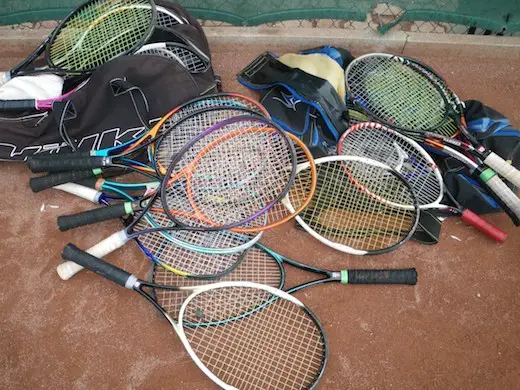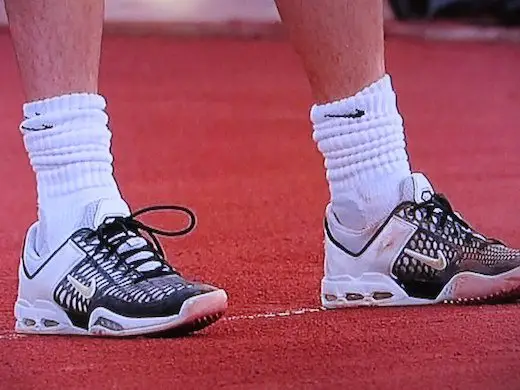- An automatic fault due to a foot stepping onto the line mid-serve
- Regularity – not overly common at the highest level
- Result – same as a regular fault
Your Guide
 Gavin Davison
Gavin Davison
If you’ve watched a fair bit of LIVE TENNIS before, you’ve probably seen a foot fault called before.
Basically, a foot fault is called by a lines judge; specifically, the baseline judge, should a player STEP ONTO THE BASELINE in the middle of their motion.

It can happen in both men’s and women’s tennis, at any level.
In fact, the number of foot faults that go un-called at the lower levels is SURPRISINGLY HIGH, since there are no lines judges.
I’ve seen guys step a good foot into the court when hitting a serve in the past. As AMUSING AS THIS IS, it’s still technically against the rules.
Mind you, you won’t get too many sticklers for calling foot faults on their opponents outside of the professional game.
With this said, I’d like to get a little more specific regarding the ins and outs of foot faults right now.
Some of this information you may already know, but much of it I hope is brand new!
A blow by blow of foot faults in tennis
As stressed above, foot faults can and DO HAPPEN in the professional game.
One of the most famous of them all was when Serena Williams was called for one during a huge US Open game against Kim Clijsters in 2009:
As you can see in the video, this foot fault call basically ended the match for Williams and gave Clijsters a walkthrough to the final.
This is, of course, an extreme example, but it UNDOUBTELY TRANSFORMED the match.
But let’s get specific regarding foot faults now.
Exactly how does foot fault occur
When serving in tennis, there are TWO METHODS relating to what you can do with your feet.
You can either ‘toe up’ or not.
If you toe up, this means that you bring your back leg forward to meet your front leg, and then use both together when springing up.
Some PEOPLE BELIEVE that this is better, but that’s a debate I will leave for another day.
Regarding foot faults, however, these are more common WITH PLAYERS who do toe up on their serve.
That’s because there is MORE MOVEMENT WITH THE FEET, meaning that more things can go wrong.
And by going wrong, I mean that one of the feet may then touch the baseline or run completely OVER IT.
That’s how a foot fault actually occurs!
According to the official rulebook, should any part of your body enter the court prior to the ball being struck, this would be a foot fault.
Once you’ve hit the ball, however, you can land in the court AS FAR AS YOU LIKE.
The Impact Foot Fault Have
If a player does perform a foot fault in a match, the impact it has IS IDENTICAL to if they have actually hit a fault.
That’s where the name comes from in the first place – foot fault.
If a player manages to step on the baseline during their first serve, the automatic fault means that they then MOVE ON to hit a second serve.
If they do this on their second serve, however, this means that they lose the point since they have then technically HIT A DOUBLE FAULT.
In terms of the impact they have in the grand scheme of things, they’re not overly influential.
That’s the case unless they occur at a MAJOR MOMENT in the match, like the example provided above in the Williams vs Clijsters game.
In cases like these, a foot fault can QUITE LITERALLY CHANGE the entire match.
Frequency In The Professional Game
Given the number of serves that are ACTUALLY HIT during the course of a tennis match, foot faults aren’t very common at all .
Sure, they do happen, but it is by means something that you can expect TO WITNESS in most matches.
In fact, if you see more than one-foot fault during a live match, you are doing well!
Ways to avoid a foot fault
Now that we’ve addressed foot faults from a definitive perspective, let’s look at how you can avoid them.
The good news is that avoiding foot faults is ACTUALLY EASIER than you might think, as detailed here.
1) Stand Further Back From The Line
Keep in mind that foot faults happen when you step over the line when serving.
Therefore, one of the BEST REMEDIES is to stand further back so that your feet are then FURTHER FROM THE LINE.
The further back you are, the LESS CHANCE you have of stepping onto the line during the middle of your motion.
But the downside of doing this is that you LOSE A FEW INCHES regarding where you contact the ball.
However, unless you are playing at a high level, you don’t need to worry too much about this.
Consider Avoiding The ‘Toe Up’
If you currently toe up with your service motion, you might want to think about CHANGING THIS.
This is ESPECIALLY TRUE if you are being called up for foot faults during your matches.
I actually changed my service motion while in college from toeing up to not, and it HELPED MY SERVE MASSIVELY.
I didn’t do this because of foot faults, but regardless, you just never know whether THIS CHANGE MIGHT HELP YOUR SERVE in general!
Keep Your Ball Toss Closer To You
Chasing a ball toss that is TOO FAR from you is another contributor to foot faults.
Basically, when you toss the ball too far, you end up chasing it and you are more likely to drag your feet over the baseline.
If you do this, of course, this results in a foot fault.
Therefore, a good way to cure the issue is to toss the ball closer to the baseline.
It still needs to be in front of your body so that you get that forward motion, but keeping it closer should GREATLY HELP with the problem.
Have any foot fault stories you wish to share? Or have you any tips/advice to help our readers stop foot faulting that isn’t mentioned? Feel free to share your thoughts below if so.



